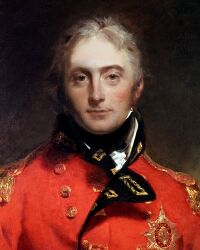Who's Who
Who's Who is a is a general encyclopedia on prominent people throught most of the history of Riamo and the Riamese Empire, first compiled by famous Watergate Publishing since its creation by William Watergate himself upon his retirement. The directory updates every decade, approximately, adding the last cabinet and president to the list, as well as people considered crucial for Riamese culture, or who "have left an important mark on it".
Who's Who has inspired multiple works across Anteria, including The Enciclopedia General del Anáhuac and others.
List
Below is a compilation of the main appearances on it throughout its editions, with a short description of each individual.
19th Century
William Watergate
main article: William Watergate
General Lord Watergate (born on 1769 to a bourgeoise family in Forlanck), best known by his title of Lord Watergate, and often nick'ed "The First Rifle", was a Riamese military and politician who became one of the leading military and political figures of 19th-century Riamo, serving twice as prime minister of the Riamese Empire.
Watergate was born in Forlanck, a rural town near Sefanville. He was commissioned as an ensign in the Royal Army in 1787, and would later be elected as a member of Parliament in the Sefan Royal Council. He was a colonel by 1796 and saw action in Gassasinia, where he fought in the Fourth Riamo-Ghassanid War at the Battle of Mansoura. He was appointed governor of the Colony of Mansoura in 1799 and, as a newly appointed major-general, won a decisive victory over the rogue confederacy at the Battle of Al-Jar in 1803.
Watergate came to prominence during the Nostrian Wars, where he earned himself a legendary reputation by leading the Southern Armies deep into Vultesian soil and later signing the Vultesian surrender at Julsz, by so earning the rank of field marshal. Upon the armistice, he briefly served as the ambassador to Vultesia, later serving twice as Riamese prime minister from 1828 to 1833, during which time he continued as one of the leading figures in the House of Lords until his retirement and remained Commander-in-Chief of the Riamese Army until his death.
Watergate is famous for his adaptive defensive style of warfare, resulting in several victories against numerically superior forces while minimizing his own losses. He is regarded as one of the greatest defensive commanders of all time, and many of his tactics and battle plans are still studied in military academies around the world. He is considered to be the pioneer of the rifle unit, whose effectiveness was proven by himself. The most famous of these became Riamo's modern anti-terrorism elite unit, which bares his name and arms.
Kate Watergate
Grandaughter of General Lord Watergate, Kate would become an orphan at 7 years old, being raised until adulthood under the wing of her grandfather, often acccompaigning him on diplomatic missions after his military retirement. She followed his steps, entering Volton's military academia at 19 years of age, participating in some minor military events on her early career.
She would eventually earn herself the title of Admiral for her contributions during the Riamese intervention in Anáhuac, where she lead several incursions into enemy territory and was the chosen signatory for the Riamese side.
Frank Sweetenham
Born to an Anahuacan father and low-class Riamese mother, Frank grew up in the outskirts of Guri and made himself a name as a good storyteller. He would go on to study economics but never really found it his passion.
After years working in a local shoemaker's shop, Frank would end up meeting Jon Dory, Diplomatic envoyee to Anahuac, which would take him under his wing. From there, Frank would slowly go up the ladder, moving to Anahuac in the 1840s and becoming deeply entrenched with local culture. He would become diplomatic advisor for Riamo in Anahuac in 1842, later becoming Chancilier in 1856.
He would become a prominent figure during the Riamese intervention in Anáhuac, where he worked as an intermediary between the Anahuacan and Riamese governments, helping set the believe that Riamese intentions were no more than a monetary issue, avoiding confrontation between the two governments unecessarily.
Yuno Gin
Kate Redly
Oto Nobosuke
Togo Tohyo
Jamy Sollow
Born in Volton in the last third of the century, Sollow is a famous Riamese post-impresionist painter, with a prolific work spanning more than 2500 works across his career.
He is considered one of the most famous Riamese painters of the 19th century.
His most well-known works are those of the "Country" series: a list of paintings depicting the daily lifes of Riamese people throughout the regions of the country. His works are known for depicting Levantine beaches and lush greenery, with simplified human anatomy, bright contrastist darks and lights, censored nudity, and hidden or mostly-covered faces.
20th Century
King Frederick
Born to beloved queen Diana I, Frederick would live most of his live under the shadow of her mother, not reching the throne but until the 1930s. His first years as monarch were unconsequential, with the Black Decade raging on and quality of life plummeting in the mainland as the once-grand Riamese Empire fell on its feet.
By the 1950s however, Frederick had started using the constitution on his favor, making a puppet of the former Riamese Parliament and its successive Prime Ministers while slowly encompassing all political power of the nation under his arms. During this time, Frederick had engineered a complex system of faulty alliances as a last attempt to save the Riamese Empire from collapse, but ultimately, he would inevitable lead the nation through the dying stages of the Empire.
By the 1960s, The cultural clashes between the Riamese and Namese evolved into large scale protests and, soon enough, terrorist attacks, favoring the independence of the Namese nation. The violent attacks on Namese protestors, as well as the tense political situation lived daily in the Parliament, evolved into a full-out localized rebellion in Nam, where barbaric war crimes were commited in several occasions in an attempt to stop the rebellion.
Frederick remained on the throne until being deposed by his daughter Diana II, who lead the country through its federalization process via the Peaceful Revolution, being poorly remembered in modern Riamese Culture due to the now-known athrocities he commited during his reign.
Diana II
Full article: Diana II Daughter of King Frederick, Diana ascended to the throne as Diana II and lead the country into its Federalization period after deposing her father as part of the Pacific Revolution, bringing the Nam War to an end with support of the riamese people and media.
Adam Wellsenton
Famous Admiral of the Riamese Navy. Lead the defense of Covire island from 2 separatist attacks onboard RSS Monarch. He is remembered for his last stand against the rebels in the Battle of Tyraloosa, which won him a Purple Star.
Cory "Robin" Red
Born in Portington, Cory became a Captain in the Riamese Army by the time the Nam War broke out. He lead the Red Robin Company to win the Battle for God's Hill near Nammington. He and his men held back more than 500 independentist armed men for more than 2 hours, which allowed riamese marines to disembark in the city and start taking its coastline. He would not survive the battle, and would later be awarded a post mortum Purple Heart.
Harold Green
Famous general of the Riamese Army. Having studied in the Portington Military Academy, Green would write a thesis about reconaissance vehicle theory that started his path into becoming General.
Samantha Robinson
Born in Crosston soon after the end of the Great war, Samantha grew to become an elite sniper as part of the Watergate Rifles. During the Nam War she scored 104 confirmed kills, which earned her the Purple Heart medal upon her return, and would eventually become Lieutenant of the Watergate Rifles. She was, and still is, the sniper with most confirmed kills of the whole Riamese Armed Forces.
Alexander Ferrier
Alexander was born in the blooming town of Victoria Port in Nashton, to a leogrian mother and Riamese father, at the dawn of the 20th century. He studied Civil Engineering and later specialized in urban transportation, eventually going on to create the world-reknown Ferrier System, a transit development method based on the lease of non-transit spaces that gain value after the construction of transit networks to a place, raising the value of the developer's assets in the area, and making transit sustainable in the long-term.
References
External links





